Petunia "Sophistika": description of varieties and rules of care
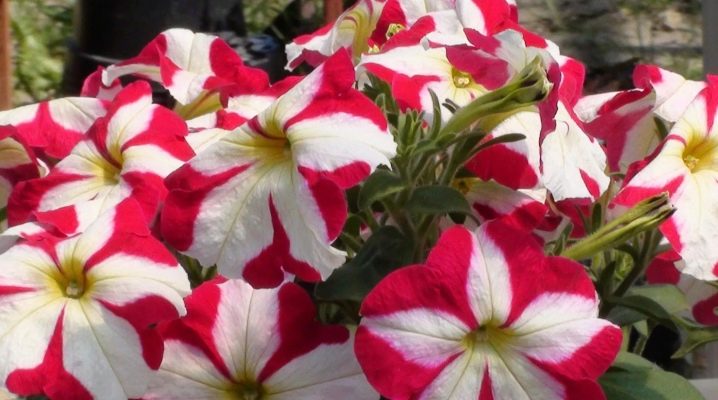
For many years, petunias have attracted flower lovers with their beauty, ease of breeding, and most importantly, an abundance of choice of colors. The neat bushes of this plant look good in flowerpots, balcony containers for flowers, in various flower beds, etc. One of the most beautiful species is the Sophistika petunia.

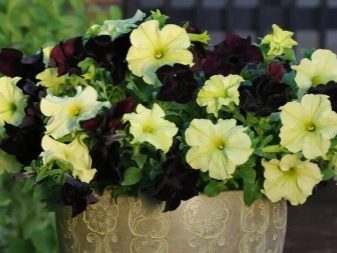
Description
"Sophistika" is a type of large-flowered petunia that has magnificent colors with a spherical shape of a bush. It differs from the rest of the petunias with a velvety texture and an interesting color, consisting of two different shades. Sophistika blooms from the beginning of July until the very frost.
This variety has different varieties. They are resistant to pests, damage, they tend to quickly recover, resume flowering.
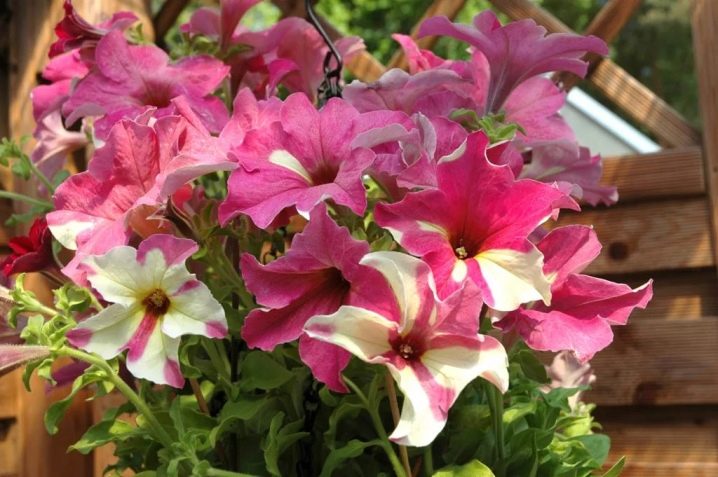
Varieties of petunias "Sophistika"
"Sophistika" belongs to the group of grandiflora, tends to change its color from light to bright. Let us consider in more detail the varieties of "Sophistika".
- "Sophistry lime bicolor" - an annual plant with a spherical bush. Diameter - up to 35 cm, height - up to 55 cm. Coloring - yellow-pink, funnel-shaped flower. The size of flowers is up to 12 cm. Depending on the light and weather, "Lime bicolor" can change the color saturation.
Seedlings can be planted only after the frost has disappeared. If planted in flower beds, it is recommended to choose a well-lit place. In dark areas, the shape of the bush is lost. Grows well on loamy, sandy loam soils. Needs additional feeding.
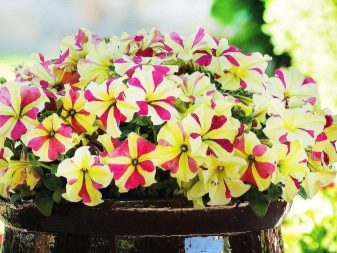

- "Sophistry Blackberry" - stocky, dwarf bush in the shape of a ball. Height - 27-40 cm, diameter - 32 cm. Flowers are rather large - about 10 cm - when opened they take the shape of a pentagon. The color of this flower is simply magical: purple-violet with black, red-blackberry. It can vary depending on the age of the plant, with a decrease in temperature, it acquires a yellowish tint.
Blooms for a long time: from about May to early November. Drought tolerant, very fond of light, but requires good watering. It is recommended to plant in pots, flowerpots, special containers for a loggia, a balcony. If planted in open ground, it is better under a roof, since with prolonged bad weather, heavy rainfall, wind, grandiflora can stop blooming.
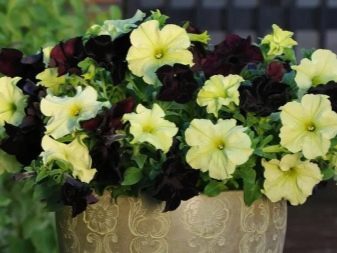

- "Blue Morne" or "Blue Morning" - a large shrub with large flowers of gorgeous blue or light blue with a white center. The shape of the flower resembles a funnel. Height - 25–40 cm, flower size - 10–12 cm. It recovers quickly after bad weather conditions.
Watering should be done regularly, but moisture should not stagnate. And also do not forget about feeding the plant, the duration of flowering will depend on this. It is best to use organic fertilizers, periodically loosen the soil between the rows.


- Blackberry & Lime - branched bushes 27–42 cm high, with small flowers 4–7 cm in diameter, but with a large number of them. The two-tone combination of black-red and yellow-lemon colors delights the eye.
Like other types of petunias, it requires timely watering without stagnant water. Withstands drought easily. It is recommended to feed with fertilizers.
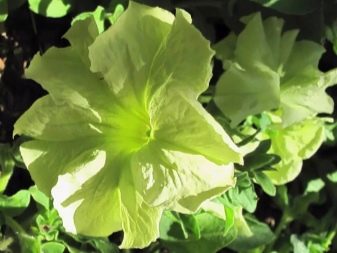
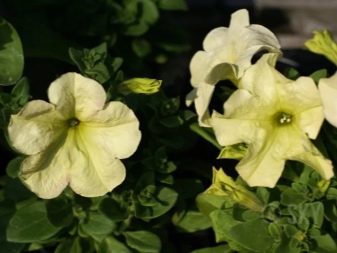
- "Antique Shades" - has a dense flowering, a height of 25–45 cm, and a flower diameter of 27–32 cm. It differs from the rest of the spherical shape, wavy edges. Coloring - light pink with yellow spots. The size and brightness of the inflorescences changes depending on weather conditions.
Like any type of petunia, "Antique Shades" requires timely watering, loosening the soil, fertilizing, removing wilting flowers and leaves. It is possible to keep the plant blooming even in winter by placing it in a lighted room at a temperature of +13 degrees and cutting off the shoots in advance.

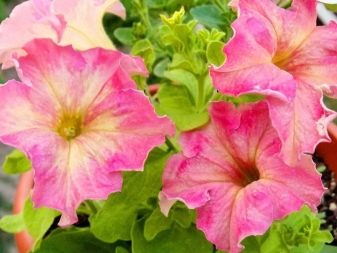
- "Shining Sapphire" - strongly branched annual shrub 30–40 cm high, with a flower diameter of 8–10 cm. The combination of bright blue and pale yellow will perfectly decorate a balcony, flowerpot, flower bed, etc. It blooms profusely, pleasing the eye with its two-tone color.
Unpretentious "Sapphire" adapts well to different weather conditions, loves good and timely watering. To improve flowering, weeding, fertilization, and removal of wilted inflorescences are recommended.
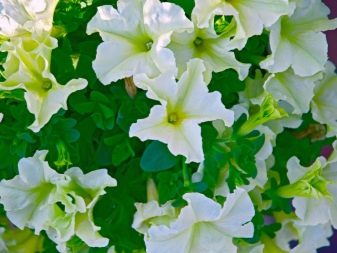
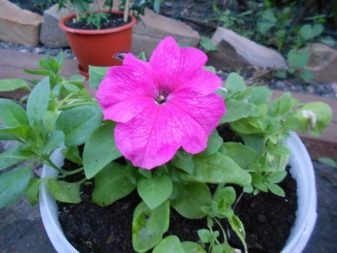
- "Splashes of champagne" - a terry spherical bush up to 38 cm high, with a large number of large flowers with a diameter of 13 cm, a beautiful rich bright pink color with yellow stripes. It will beautifully decorate the balcony, flower pots, the front entrance of the building, lawns.
It is planted in the ground after frost, requires moisture, but not stagnant water. It is preferable to plant in sandy loam soil, fertilize with suitable substances, remove withered shoots.

- "Lime green" Is a gorgeous large-flowered bush with a bright lemon-yellow or lemon-green color. Flowering height - 27–32 cm, diameter - 8–11 cm. Looks beautiful in hanging baskets, ridges, large flower beds.
It tolerates drought well, but loves light. It grows in any nutrient soil. Withstands any weather conditions, quickly recovers with minor damage.


- "Twilight" - a bush with a bright pink or light purple flower with a yellow center, 23–36 cm high, 8–10 cm in diameter. The plant is distinguished by its branching.
You will need to moisturize often, but you should not fill it. Also do not forget about feeding the plant - this action will prolong flowering. It is best to choose organic fertilizers, if possible, loosen the soil between the rows.
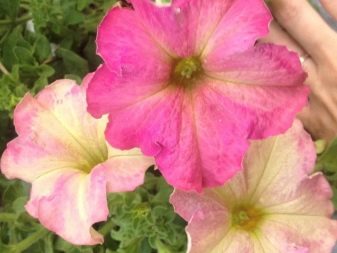
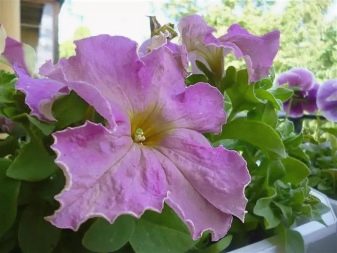
Breeding tips
The question often arises of how to multiply the variety of petunias you like when you don't want to buy seeds every year. This type of terry large-flowered petunia is propagated by cuttings. Let's look at some tips on how to make it right.
- Cuttings should be made from February to May.
- It is permissible to use last year's mother bushes and young plants that have grown from seeds.
- The largest bushes with the largest flowers should be selected from the mother plants.
- Plants should be stored for storage at the end of summer.
- At the end of winter, you should take care of the cuttings of the petunia. It is necessary to cut off the tops-cuttings from the mother liquors, cut them into 10 centimeters.
- Two, three sheets on top should be cut in half, the rest should be removed.
- Next, you need to place the cuttings in loose soil with moist sand. Drizzle a little.
- When the cuttings have fibrous roots, plant in pots with further care, as for any seedlings.
- If the reproduction was successful, then in mid-May you can transplant the seedlings to any convenient place.

Review of the petunia "Sophistika", see below.







































































































The comment was sent successfully.